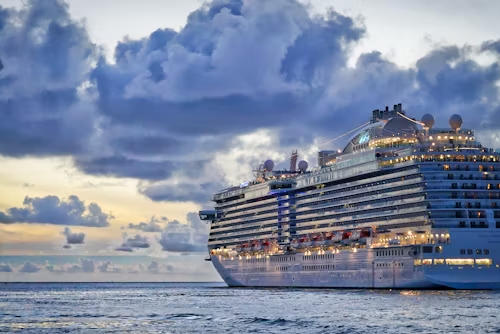Cruise lines are gaining traction as a popular and more affordable option compared to traditional hotels, even amid rising prices. Despite the increases, cruises remain cheaper than land-based accommodations, allowing the industry to stand out as some weaknesses emerge in other travel sectors.
Demand for cruises continues to be robust, showing no signs of slowing down. The cruise industry was one of the last to recover from the COVID pandemic, but now it is enjoying strong pricing and booking momentum. While price growth is starting to stabilize, it remains well above inflation rates, according to Patrick Scholes, a travel and leisure analyst at Truist. “Cruise companies are having a moment right now,” he noted in a CNBC interview.
Hilton CEO Christopher Nassetta recently remarked that leisure travel demand in the U.S. is “flat, maybe even a little down,” highlighting the contrasting strength of the cruise market. Barclays analyst Brandt Montour noted that the cruise industry’s continued strength in bookings is primarily driven by its significant price advantage over land-based vacations, combined with higher service levels.
As of the second quarter, major cruise operators reported net revenue per diems 17% higher than in 2019. In contrast, Caribbean hotel prices have surged by approximately 54% since 2019, and U.S. resort prices have increased by 24%, according to Montour.
Carnival CEO Josh Weinstein acknowledged that declines in other travel sectors could benefit his company. He stated, “If the consumer is slowing down in other sectors, that bodes well for us to attract those customers, as we offer a better experience at a better price.”
The price disparity between hotels and cruises isn’t new, largely because hotel demand often comes from business travelers, while cruise demand is driven by leisure travelers who are more price-sensitive, explained UBS analyst Robin Farley. However, this gap has widened in recent years, suggesting more growth potential for cruise lines.
Farley pointed out that the rise in direct bookings for cruises since 2019 means fewer commissions paid to travel agents, which impacts per diem calculations. She estimates that if the share of direct bookings increased by 5 to 10 percentage points, it could significantly boost reported net per diems.
Additionally, the three major cruise lines have enhanced bundled and presold onboard revenue, contributing to a greater price gap between cruises and hotels. Farley sees potential for Royal Caribbean to further capitalize on this gap due to its private island, CocoCay, which features attractions that generate additional revenue.
All three cruise lines are also rolling out high-speed internet via Starlink onboard, potentially boosting passenger revenue further. “The wider that gap, the better the opportunity for cruise lines,” Farley said.
Truist’s Scholes noted that any increase in pricing is crucial for cruise operators, given their high fixed costs. “One extra point of pricing is extremely material to profitability,” he added.
Wall Street analysts maintain a positive outlook for cruise operators. Scholes remarked that these companies are now competing against a wider array of attractions, such as theme parks and vacation destinations, rather than just each other.
Royal Caribbean has set the bar with its unique private island, CocoCay, which offers various paid amenities. The company’s latest ships, including the Icon of the Seas and Utopia of the Seas, are also designed to attract first-time cruisers, showcasing a variety of short getaway options.
Both Royal Caribbean and Carnival hold an average rating of “overweight” from analysts, with Royal Caribbean showing a nearly 56% gain year-to-date. Carnival recently reported record operating income and raised its 2024 earnings estimates, fueled by strong demand and cost-saving measures.
Carnival’s future looks promising, especially with its new island, Celebration Key, set to open in July. This addition is expected to drive interest and bookings.
However, Scholes noted that Carnival faces pricing competition from private cruise operator MSC. Shares of Carnival have underperformed, rising about 13% this year, compared to a 22% increase in the S&P 500.
Norwegian Cruise Line Holdings also has an average rating of “overweight,” with analysts predicting a 4% upside to its average price target. Citi recently upgraded Norwegian’s stock, boosting its price target and suggesting substantial growth potential.
While Norwegian hasn’t announced a private island experience, Scholes anticipates they will introduce a competitive offering by 2026. This stock has also underperformed, with a nearly 16% increase year-to-date.
Overall, cruise lines are positioning themselves as an appealing and cost-effective alternative in the travel landscape, with strong demand and growth potential ahead.








